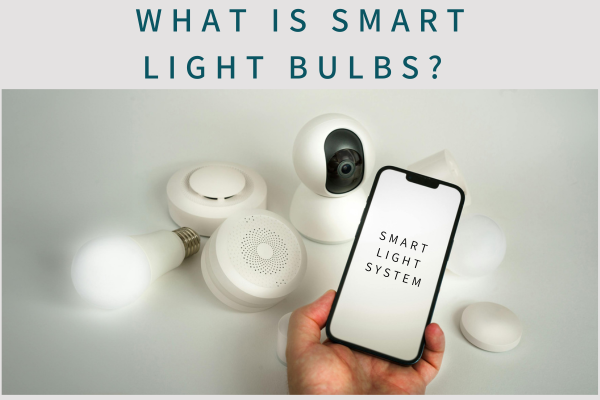
In today’s fast-paced world, technology has seamlessly integrated into our homes, revolutionizing the way we live. Smart home devices, in particular, have gained immense popularity, offering convenience, comfort, and energy efficiency. Among these devices, smart light bulbs have emerged as a standout, transforming ordinary lighting into a customizable and intelligent experience.
As the smart home market continues to expand, smart light bulbs have emerged as a must-have accessory for those seeking to enhance the functionality, efficiency, and ambiance of their indoor environments. These sophisticated bulbs seamlessly integrate with a wide range of smart home ecosystems, allowing users to effortlessly control, customize, and schedule their lighting with the tap of a finger or the sound of their voice.
The key advantages of incorporating smart light bulbs into your home are numerous. Firstly, these bulbs boast remarkable energy efficiency, often consuming significantly less power than their conventional counterparts while providing the same, if not superior, illumination. This not only translates to substantial savings on utility bills but also contributes to a more eco-friendly and sustainable lifestyle.
Moreover, smart light bulbs offer unparalleled customization capabilities. Users can choose from a vast array of color temperatures and hues, creating the perfect ambiance for any occasion, whether it’s a cozy evening or a lively gathering. The ability to schedule and automate lighting patterns further enhances the convenience and personalization of the smart home experience.
As the smart home market continues to evolve, the integration of smart light bulbs has become increasingly seamless, allowing for seamless connectivity with a wide range of smart devices and virtual assistants. This integration enables homeowners to effortlessly control their lighting from the comfort of their smartphone or through voice commands, streamlining their daily routines and elevating the overall smart home experience.
Types of Smart Light Bulbs
In today’s world of connected devices, smart light bulbs have become a popular way to add convenience, energy efficiency, and customization to home lighting. Whether you’re looking to create the perfect ambiance, set automated schedules, or integrate your lights with other smart home technologies, there is a wide array of smart bulb options to choose from. The main types of smart light bulbs on the market can be divided into three main categories based on their connectivity method:
Wi-Fi Smart Light Bulbs
Wi-Fi enabled smart bulbs connect directly to your home wireless network, allowing you to control them remotely using a smartphone app or voice commands. These bulbs offer the widest compatibility, as they can typically be integrated with popular smart home platforms like Amazon Alexa, Google Assistant, Apple HomeKit, and Samsung SmartThings. Wi-Fi bulbs also tend to have the most robust feature sets, including features like tunable white color temperatures, color changing, scheduling, and integration with IFTTT. Examples of Wi-Fi smart bulbs include the Philips Hue, LIFX, and TP-Link Kasa lines.
Bluetooth Smart Light Bulbs
Bluetooth smart bulbs connect directly to your smartphone or tablet via Bluetooth, providing a simple and affordable way to add smart lighting to your home. While Bluetooth bulbs do not offer the same level of remote accessibility as Wi-Fi models, they provide a quick and easy way to control your lights locally. Bluetooth bulbs are often a good option for those looking to add smart lighting to a single room or smaller space. Prominent Bluetooth smart bulb brands include Sengled, TP-Link, and LIFX.
Z-Wave and Zigbee Smart Light Bulbs
Z-Wave and Zigbee are alternative wireless protocols used by some smart light bulbs. These mesh network technologies allow bulbs to communicate with a central hub, which then connects to your home network and smart home platform. Z-Wave and Zigbee bulbs tend to have longer ranges and better reliability compared to Wi-Fi or Bluetooth, making them a good choice for larger homes. However, they require the purchase of a compatible smart home hub, adding to the overall cost. Popular Z-Wave and Zigbee smart bulb options include those from GE Lighting, Cree, and Sylvania.
When choosing the best smart light bulbs for your home, it’s important to consider factors such as your preferred connectivity method, required features, and integration with your existing smart home ecosystem. By understanding the differences between Wi-Fi, Bluetooth, and Z-Wave/Zigbee bulbs, you can select the right smart lighting solution to meet your needs and elevate the intelligence of your home.
The Advantages dan Disadvantages of Smart Light Bulbs
Advantages
Smart light bulbs offer a multitude of advantages that make them the best choice for your home. From energy efficiency to convenience and control, these innovative bulbs are revolutionizing the way we light our spaces. Let’s explore the benefits of smart light bulbs in detail.
One of the key advantages of smart light bulbs is their energy efficiency. By utilizing LED technology, these bulbs consume less energy compared to traditional incandescent bulbs. This not only helps reduce your electricity bills but also contributes to a greener environment. With smart light bulbs, you can enjoy bright and vibrant lighting while being mindful of your energy consumption.
Another major advantage of smart light bulbs is the convenience they offer. With the ability to be controlled remotely through smartphone apps or voice assistants, you have complete control over your lighting. Adjusting brightness, color, and schedules is as easy as a few taps on your phone or a simple voice command. Whether you want to dim the lights for a cozy movie night or set a schedule to wake up gently in the morning, smart light bulbs provide unparalleled convenience at your fingertips.
Smart light bulbs take customization to a whole new level. With a wide range of colors and dimming options, you can create different moods and enhance the ambiance of any room. Whether you want a warm and cozy atmosphere for a relaxing evening or vibrant colors for a party, smart light bulbs allow you to effortlessly transform your space. The ability to adjust the lighting according to your preferences adds a personal touch and makes your home truly unique.
In addition to these advantages, it’s worth mentioning that there are various options available when it comes to choosing the best smart light bulbs for your home. You can find a list of the best smart light bulbs along with their features, allowing you to make an informed decision based on your specific needs and preferences. It’s important to consider the price range of the best smart light bulbs, as well as their pros and cons, to ensure you find the perfect fit for your home.
Disadvantages
When it comes to smart light bulbs, there are a few drawbacks that you should consider before making a purchase. While they offer many advantages, it’s important to be aware of the potential disadvantages as well.
One of the main disadvantages of smart light bulbs is the higher upfront cost compared to traditional bulbs. The best smart light bulbs on the market can be quite expensive, especially if you’re looking for top-notch features and quality. However, it’s important to keep in mind that these bulbs are designed to be energy-efficient and long-lasting, which can help offset the initial investment over time.
Another disadvantage to consider is compatibility issues. Before buying smart light bulbs, it’s crucial to check if they are compatible with your existing lighting fixtures and smart home systems. Not all bulbs work with every type of fixture or system, so it’s essential to do your research beforehand. This can save you from the frustration of purchasing bulbs that won’t work with your setup.
One potential inconvenience of relying on smart light bulbs is their dependence on technology. If the internet or power goes out, the smart features of these bulbs may become temporarily unavailable. This means you won’t be able to control them remotely or use any automated features until the connection is restored. While this may not be a major issue for everyone, it’s something to consider if you live in an area with frequent power outages or unreliable internet service.
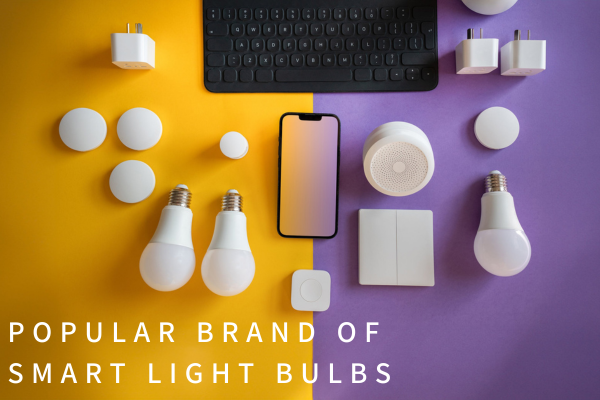
Top Smart Light Bulb Recommendations
Philips Hue
Philips Hue is a renowned brand in the smart home lighting market, offering a comprehensive range of connected light bulbs and fixtures that provide users with unparalleled control and customization options. Renowned for their innovative technology and versatility, Philips Hue smart light bulbs have become a go-to choice for those seeking to enhance their living spaces with intelligent lighting solutions.
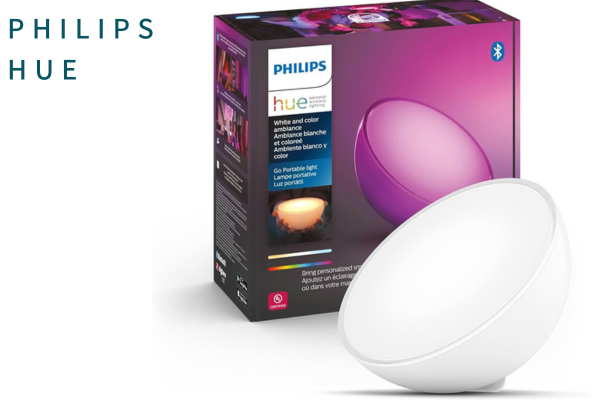
Features and Benefits
- Wide range of color options (16 million colors)
- Adjustable brightness
- Voice control compatibility (Alexa, Google Assistant, Siri, Samsung SmartThings)
- App control for remote operation and scheduling
- Smart hub required for full functionality
- Offer a wide range of color temperatures, from warm, cozy whites to cool, energizing hues,
- Able to create custom color palettes.
- Designed to be energy-efficient, using up to 80% less energy than traditional bulbs.
Pros
- Excellent color accuracy and brightness
- Extensive ecosystem of products
- Reliable and easy to use
- Integrated with smart home platforms
- Reliable and responsive performance
- Energy-efficient design
- Durable and long-lasting
Cons
- Requires a hub for most features
- Relatively higher initial cost compared to traditional light bulbs
- Requires a Philips Hue Bridge for full functionality
- Limited compatibility with certain smart home platforms
Price Range
| Varies depending on the model, but typically starts around $50 per bulb. While a starter kit, which includes a Hue Bridge and multiple bulbs, can cost between $99.99 and $199.99. |
LIFX
LIFX is a renowned brand in the smart lighting industry, offering a range of feature-rich LED bulbs. The LIFX bulbs are Wi-Fi-enabled, allowing for easy integration and control through smartphone apps or voice assistants like Amazon Alexa and Google Assistant.The bulbs offer a wide range of colors and shades, allowing you to customize your lighting experience to suit your mood.
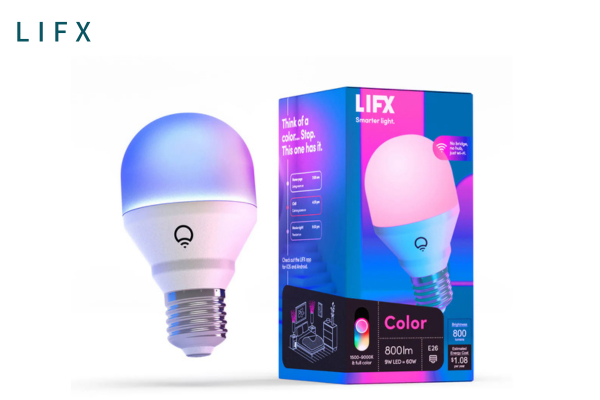
Features and Benefits
- Wi-Fi connectivity (no hub required)
- Wide range of color options (over 16 million colors)
- Adjustable brightness or color temperature from warm to cool white
- Voice control compatibility (Alexa, Google Assistant, Siri)
- App control for remote operation and scheduling
- Dimmable functionality for setting the perfect ambiance
- Customizable lighting schedules and scenes
Pros
- Easy to set up and use
- Wide range of features
- Good color accuracy
- Versatile lighting
- Seamless smart home integration
- Reliable performance
Cons
- More expensive than some other options
- Can be less reliable than other brands
- LIFX bulbs have limited compatibility with other smart devices.
Price Range
| Starts around $30 per bulb. |
TP Link
TP-Link Kasa Smart Bulb is a budget-friendly option that offers basic smart lighting features. These bulbs are easy to set up and control through the Kasa app.
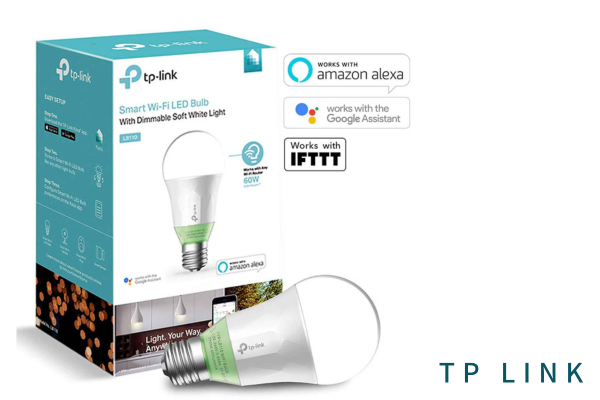
Features and Benefits
- No need for a separate hub, connect directly to your Wi-Fi network.
- Compatible with Amazon Alexa and Google Assistant for hands-free control.
- Control your lights from anywhere using the Kasa app.
- Create custom schedules to automate your lighting.
- Adjust the brightness and colors to suit your mood or activity.
- Compatibility with IFTTT for advanced automation
- Energy-efficient design with long-lasting LED technology
Pros
- Easy to set up and use.
- Affordable pricing.
- Reliable performance.
- Wide range of features.
- Compatible with popular voice assistants.
- Robust app and voice control
- Broad smart home integration.
Cons
- App can be a bit clunky at times.
- Not as many customization options as some higher-end brands.
- Limited color changing capabilities compared to premium options.
- The color accuracy of TP-Link Kasa bulbs may not be as precise as some of the higher-end options.
Price Range
| Varies depending on the model and retailer, but generally starts around $15 per bulb. |
Wyze
The Wyze Bulb is a budget-friendly smart lighting option that offers impressive features for its low cost. It connects to Wi-Fi and can be controlled via the Wyze mobile app or voice commands through Amazon Alexa or Google Assistant.
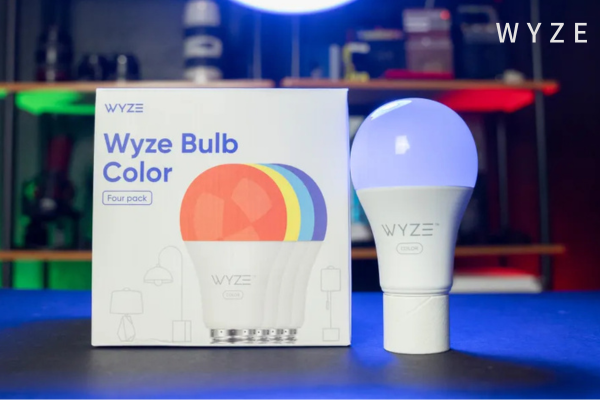
Features and Benefits
- Affordable pricing
- Voice control compatibility (Alexa, Google Assistant)
- App control for remote operation and scheduling
- Energy-efficient
- Adjustable brightness levels from 1% to 100%
- Ability to change color temperature from warm to cool white
- Scheduling and automation capabilities
- Integration with Wyze smart home ecosystem
Pros
- Very affordable
- Easy to set up and use
- Good color accuracy
- Reliable connectivity.
Cons
- Limited features compared to more expensive options
- Not as reliable as some other brands
- Limited color changing options compared to premium bulbs.
Price Range
| Starts around $15 per bulb. |
GE C-Life Smart Bulb
The GE C-Life Smart Bulb is a cost-effective option that offers basic smart lighting functionality. It connects to Wi-Fi and can be controlled through the C by GE mobile app or voice commands using Amazon Alexa or Google Assistant.
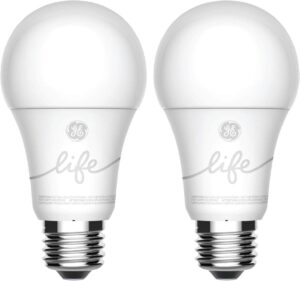
Features and Benefits
- Easy to install and connect to your Wi-Fi network.
- Compatible with Amazon Alexa and Google Assistant.
- Control your lights from anywhere using the C-Life app.
- Create custom schedules to automate your lighting.
- Adjust the brightness to suit your needs.
- LED technology reduces energy consumption.
Pros
- User-friendly interface.
- Reliable performance.
- Affordable pricing.
- Good color accuracy
- Durable and long-lasting
Cons
- Limited customization options compared to some other brands.
- App could be more feature-rich.
- Limited color changing options,
- No integration with third-party smart home platforms.
Price Range
| Varies depending on the model and retailer, but generally starts around $15 per bulb. |
Govee
Govee is a reputable brand in the smart lighting industry, offering a wide range of customizable and energy-efficient lighting solutions. Their smart light bulbs are designed to enhance the ambiance and mood of any living space.
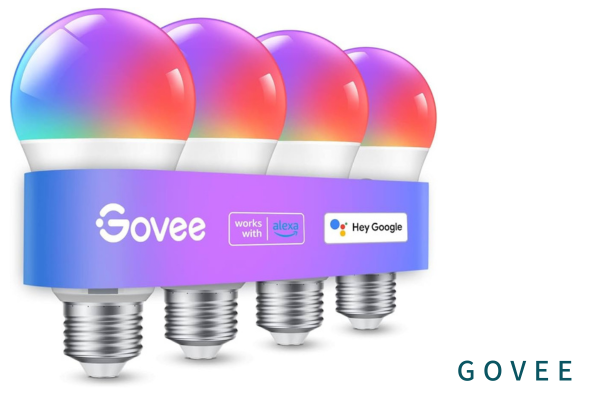
Features and Benefits
- Wide range of products, including bulbs, light strips, and outdoor lights
- Affordable pricing
- Voice control compatibility (Alexa, Google Assistant, Apple Homekit)
- App control for remote operation and scheduling
- Govee bulbs offer a wide range of color options, from warm white to vibrant RGB, enabling you to create the perfect lighting atmosphere for your needs.
- The bulbs provide adjustable brightness levels, allowing you to set the ideal illumination for any room or occasion.
- Govee’s smart app allows you to create custom schedules and timers, ensuring your lights are automatically turned on or off at your preferred times.
- Govee bulbs are designed to be energy-efficient, helping you save on electricity costs while reducing your carbon footprint.
Pros
- Affordable pricing compared to some premium smart bulb brands.
- Easy setup and integration with various smart home ecosystems.
- Extensive color options and customization capabilities.
- Energy-efficient design for long-lasting performance.
Cons
- App can be a bit clunky
- Not as reliable as some other brands
- Limited advanced features compared to higher-end smart bulb brands.
- Potential connectivity issues or app instability, depending on the user’s network and device compatibility.
Price Range
| Range from $10 to $30 per bulb, depending on the features and bundle options. |
Nanoleaf
Nanoleaf is a renowned brand that has gained popularity for its innovative and visually stunning smart lighting solutions, including their line of smart light bulbs.
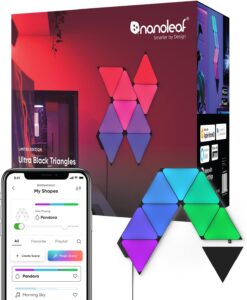
Features and Benefits
- Unique designs (shapes, panels, lines)
- Customizable lighting effects
- Voice control compatibility (Alexa, Google Assistant, Siri)
- App control for remote operation and scheduling
- Nanoleaf bulbs offer a wide range of color options, including millions of shades, allowing you to create personalized lighting experiences.
- Nanoleaf’s smart bulbs can synchronize with music and videos, providing a captivating and immersive lighting experience.
- Nanoleaf bulbs can be controlled using touch gestures or voice commands through compatible smart home assistants.
- Nanoleaf’s app enables you to create and save custom lighting scenes, making it easy to set the perfect ambiance.
Pros
- Beautiful and unique designs
- Many customization options
- High-quality build
- Innovative and visually striking design that enhances the decor.
- Robust color customization and synchronization capabilities.
- Intuitive touch and voice control features.
- Extensive customization options for lighting scenes and effects.
Cons
- More expensive than traditional bulbs
- Limited compatibility with some smart home platforms, depending on the specific model.
- Potential complexity in setup and configuration for some users.
Price Range
| Varies depending on the product, but typically starts around $100. |
Each of these smart light bulbs offers unique features and benefits, catering to different budgets and preferences. Customers should carefully consider their specific needs and smart home ecosystem requirements when selecting the most suitable option.
Factors to Consider When Choosing Smart Light Bulbs
When selecting the perfect smart light bulbs for your home, several key features should be considered:
Color Temperature
Color temperature, measured in Kelvin (K), significantly impacts the ambiance of a room. A lower color temperature (2700K) produces a warm, soft light, ideal for relaxation and winding down. Conversely, a higher color temperature (6500K) emits a bright, cool light, perfect for focused tasks like reading or working. The ability to adjust color temperature allows you to tailor the lighting to your specific needs and preferences.
Color Range
A wide color spectrum empowers you to create a diverse range of moods and atmospheres. From the soft glow of a sunrise to the vibrant hues of a sunset, smart bulbs with millions of color options offer endless possibilities. Whether you’re hosting a party, setting the mood for a romantic dinner, or simply adding a touch of personality to your space, the ability to customize colors provides unparalleled flexibility.
Brightness
Adjustable brightness is crucial for adapting to different lighting conditions and activities. Whether you need a bright light for reading or a dim light for watching TV, smart bulbs offer precise control over light intensity. This feature ensures optimal visibility and comfort, reducing eye strain and promoting a pleasant environment.
Voice Control Compatibility
Voice control integration with popular assistants like Alexa, Google Assistant, and Siri revolutionizes the way you interact with your smart lights. With simple voice commands, you can effortlessly turn lights on and off, adjust brightness, change colors, and create custom lighting scenes. This hands-free convenience elevates the smart home experience.
App Control
A dedicated smartphone app empowers you to remotely control your smart lights from anywhere in the world. This flexibility allows you to turn lights on and off, adjust brightness and color temperature, and create custom schedules, even when you’re away from home. App control also enables you to group multiple lights together and control them simultaneously, streamlining your lighting management.
Smart Hub Compatibility
Smart hub compatibility allows you to integrate your smart lights with other smart home devices, creating a cohesive and interconnected ecosystem. By connecting to hubs like SmartThings, HomeKit, or others, you can automate tasks, trigger lighting scenes based on specific conditions, and enjoy a seamless smart home experience.
Energy Efficiency
Smart light bulbs are designed to be energy-efficient, consuming significantly less power than traditional incandescent bulbs. By optimizing lighting usage and reducing energy consumption, you can lower your electricity bills and contribute to a more sustainable future. Additionally, many smart bulbs offer features like automatic on/off scheduling and energy-saving modes, further enhancing their eco-friendly credentials.
By carefully evaluating these key factors, you can select smart light bulbs that seamlessly integrate with your smart home, provide the desired lighting features, and deliver energy-efficient, long-lasting performance.
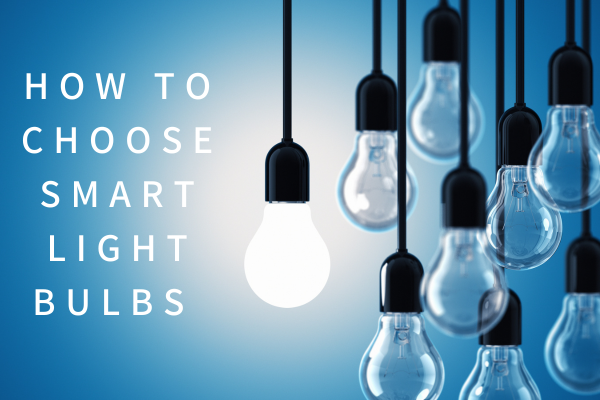
Buying Guide
When investing in smart light bulbs, consider the following factors to ensure a seamless and satisfying experience:
Compatibility
- Determine your existing smart home ecosystem (e.g., Alexa, Google Assistant, Apple HomeKit). Choose bulbs compatible with your preferred voice assistant and smart home hub.
- Decide whether you prefer Wi-Fi-enabled bulbs that connect directly to your network or hub-based bulbs that require a central hub for communication.
Desired Features
- Consider whether you prefer a wide range of colors or just basic white and warm white.
- Consider the importance of adjustable color temperature to suit different moods and activities.
- Assess the need for a wide color spectrum, particularly if you enjoy creating various lighting atmospheres.
- Determine the required brightness levels for your specific needs, whether it’s soft ambient lighting or bright task lighting.
- Is voice control important to you? If voice control is essential, ensure the bulbs are compatible with your preferred voice assistant.
- Evaluate the convenience of app control for remote operation, scheduling, and customization.
- Prioritize energy-efficient bulbs to reduce your carbon footprint and lower energy costs.
- If you have a smart home hub, check compatibility to create a seamless connected home experience.
Installation Ease
- Screw-In Bulbs: These are the most common type and are easy to install, replacing traditional bulbs in your existing fixtures.
- Specialty Bulbs: Some bulbs may require specific fixtures or additional hardware, so check compatibility before purchasing.
Budget
- Set a Budget: Determine your budget to narrow down your options.
- Consider Long-Term Costs: While upfront costs may vary, factor in potential energy savings and the convenience of smart lighting.
Compare Prices
- Compare prices from different retailers to find the best deals.
- While upfront costs may vary, factor in potential energy savings and the convenience of smart lighting.
Additional Tips
- Read Reviews from other users to gain insights into product performance, reliability, and ease of use.
- Check tech websites and blogs for expert reviews and comparisons of different smart bulb brands and models.
- Check Warranty: A good warranty can provide peace of mind and protection against defects.
- Future-Proofing: Consider the brand’s reputation and commitment to future updates and features.
Don’t Be Afraid to Experiment
- Start Small: Begin with a few bulbs to test the technology and see how it fits into your lifestyle.
- Try Different Brands: Experiment with different brands to find the best fit for your needs and preferences.
- Consider Future Expansion: Choose a brand with a wide range of products to expand your smart lighting setup in the future.
By carefully considering these factors, you can select the best smart light bulbs to elevate your home’s ambiance, enhance your lifestyle, and enjoy the benefits of smart technology.
In conclusion, smart light bulbs have revolutionized the way we illuminate our homes, offering a myriad of benefits beyond traditional lighting. By providing remote control, scheduling capabilities, and customizable color options, these innovative devices enhance convenience, energy efficiency, and overall lifestyle.
As you embark on your smart lighting journey, remember to consider your specific needs and preferences. Factors such as color temperature, brightness, voice control compatibility, and energy efficiency should be carefully evaluated. By selecting the right smart bulbs and effectively utilizing their features, you can create a personalized and dynamic lighting experience that elevates your home’s ambiance and functionality.
For those seeking to delve deeper into the world of smart home technology, exploring additional smart devices like smart thermostats, smart speakers, and smart security systems can further optimize your home’s efficiency and security.




